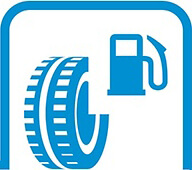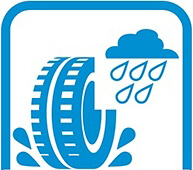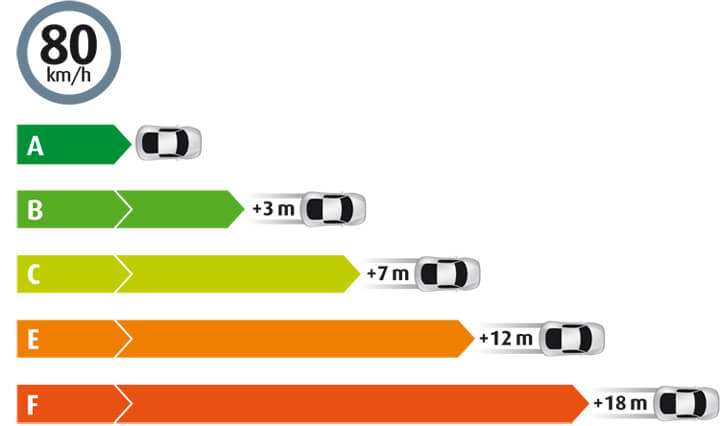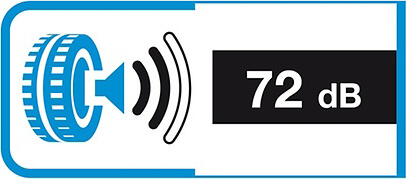Purchasing tyres isn't a task to be taken lightly! There are many factors to take into account that may influence your choice when replacing your tyres.
It's difficult to give an exhaustive list of points to consider when buying tyres. So, we'll simply give a list of examples:
- How important is the brand to you?
- What type of vehicle do you have?
- Driving performance (on dry ground, wet ground, in a straight line, when braking, at high speed, wear, grip, traction...)
- What's your budget?
- Which season are they for?
The European legislator has therefore tried to standardise and regulate three main (and universal) criteria to help you navigate the jungle the tyre-sales market.
The aim is to give the consumer and tyre user factual information, allowing them to judge tyre performance.
Want to find out more about the EU Tyre Label?
Definition
European tyre labelling has been regulated under the EC 1222/2009 standard by the European Commission (SEC) since 2008. It came into force on 1st November 2012. This regulation objectively measures the performance of your tyres based on three fundamental performance criteria:
- The environmental criterion -> measured by fuel consumption
- The safety criterion -> measured by the wet braking distance
- The comfort criterion -> measured by noise emissions
These criteria are precisely standardised to avoid variations in performance depending on the equipment used, the speeds and vehicles used during the tests, the temperatures and type of ground surface, and any other factors influencing the results.
The results are declared by the tyre manufacturers. Inspection bodies exist on both national and European Union levels.
What is the purpose of the European tyre label?
The primary objective of this label is to give the consumer more insight into the actual performance of tyres, thus avoiding marketing gimmicks and other product brand images.
The second objective is to push tyre manufacturers to produce tyres of better environmental quality that are safer and more comfortable for users.
Which tyres are covered by the European tyre label?
All new car, van, and truck tyres manufactured since 1st July 2012 are required to undergo tests European tyre label tests.
Only motorbike, quad bike, retreaded, off-road, racing, vintage-car, spare-wheel, and studded tyres are not legally obliged to undergo the tests. Therefore, only these tyres can be marketed without tyre labelling.
How do I read a European tyre label?
The label has been designed using colours and value scales to allow you to quickly see the performance of a tyre.

Few consumers know the meanings of the tests and results behind the icons, colours, grades, and scale of values.
What is rolling resistance (a.k.a fuel consumption)?

The rolling resistance of a tyre corresponds to the amount of energy used by a tyre when in friction with the road. A tyre's rolling resistance uses 20% to 30% of the vehicle's energy.
The test thus consists of measuring:
- the fuel consumption of a tyre at a speed of 60 mph
- under identical conditions (tyre size, speed, power, weight, temperature)
with a test rig (machines approved by the European Union).
Tyres are graded on six categories ranging from the letter A to the letter G.
The difference between two letters corresponds to a consumption of approximately +/- 0.1 litres per 60 miles covered.
For example, between two tyres that are used identically, a tyre rated 'A' for fuel consumption will 'consume' about 0.5 litres less per 60 miles travelled than a tyre rated 'G'
How is grip measured when braking on wet surfaces?

Difficult conditions are ideal for measuring tyre safety. The test is therefore carried out on wet roads at a speed of 50 mph and measures emergency braking distance.
The number of metres travelled between the moment the brakes are solicited and the moment the vehicle comes to a standstill is then measured and recorded on the label.
A vehicle graded 'A' has a braking distance of less than 28 metres. 'D' & 'G' grades are not in use.
This table shows the braking differences by category:
| Braking grades on wet ground. | Braking distance | Difference in metres between the grade and the 'A'. |
|---|---|---|
| A | 28 metres | |
| B | 31 metres | +3 metres |
| C | 35 metres | +7 metres |
| D | ||
| E | 40 metres | +12 metres |
| F | >46 metres | >+18 metres |
| G |
If we take the size of a pedestrian crossing (3 metres), it means that a vehicle with an 'A' rating for braking on wet ground will stop the equivalent of six pedestrian crossings before a vehicle with an 'E' rating.

How is tyre noise output measured?

Tyres create noise when in use. The sound comes from the passage of air between the tyre and the ground and from friction between the ground and the tyre.
These emissions are recorded and measured on a test rig.
The result is given in decibels (dB) and symbolised by three noise bars on the label's pictogram.
Here are the different noise emissions:
| Bar shown on the pictogram | Sound emission in dB |
|---|---|
| 1 bar | =<67dB |
| 2 bars | Between 67db and 71dB |
| 3 bars | Between 72db and 76dB |
Where can I find my tyre's EU label?
The tyre label must be available to motorists and tyre purchasers before, during, and after purchase.
Before buying your tyres:
At the point of sale: tyre distributors are required to display the labels in the showroom and storage area. If the label becomes detached from the tyre's tread, the information must be made available immediately.
Online: the site is required to put on the search result pages, as well as on each product description, the results and visuals of the labelling for each tyre offered for sale and subject to labelling.
The label is standardised (size, font used, colour scheme).
After buying your tyres:
Invoices for tyres purchased on the Internet or in stores must include the size, brand and model of your tyres, as well as the grades for the three criteria constituting the European label.
What are the limits of the European tyre label?
The presence of the label gives a better view on tyre performance. The tyre label also gives the consumer a better understanding of how to compare different tyres.
On the other hand, the label is limited to three criteria. However, when a manufacturer develops new products, it is based on more than 30 different objective and subjective criteria such as: braking on dry ground, braking on snow, low-speed swerving, high-speed swerving, driving comfort, mileage; grip on dry ground, snow, and ice...
In addition, while the label is generally a good indicator for summer and all-season tyres, it's less suitable for winter tyres.
What are the differences between the European tyre label and the American UTQG?
The European label and the American UTQG both aim to help consumers to find their way around. On the other hand, the test criteria are different, as are the methods.
So it's very difficult to compare these 2 rating systems.
